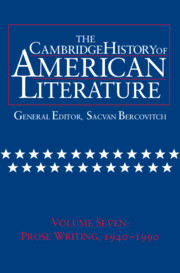Book contents
- Frontmatter
- Introduction
- The Drama, 1940—1990
- Fiction and Society, 1940–1970
- After the Southern Renascence
- Postmodern Fictions, 1960–1990
- Emergent Literatures
- 1 From Marginal to Emergent
- 2 Comparative Racism and the Logic of Naturalization
- 3 Nisei Sons and Daughters
- 4 Legacies of the Sixties
- 5 Refusing to Go Straight
- 6 Beyond Hybridity
- Appendix: Biographies
- Chronology, 1940–1990
- Bibliography
- Index
3 - Nisei Sons and Daughters
from Emergent Literatures
Published online by Cambridge University Press: 28 March 2008
- Frontmatter
- Introduction
- The Drama, 1940—1990
- Fiction and Society, 1940–1970
- After the Southern Renascence
- Postmodern Fictions, 1960–1990
- Emergent Literatures
- 1 From Marginal to Emergent
- 2 Comparative Racism and the Logic of Naturalization
- 3 Nisei Sons and Daughters
- 4 Legacies of the Sixties
- 5 Refusing to Go Straight
- 6 Beyond Hybridity
- Appendix: Biographies
- Chronology, 1940–1990
- Bibliography
- Index
Summary
Naomi Nakane, the narrator of Joy Kogawa’s novel Obasan (1981), looks at the box of journals, letters, and government documents that she has received from her Aunt Emily and thinks to herself, “Crimes of history … can stay in history. What we need is to concern ourselves with the injustices of today” Naomi calls her activist aunt “a world warrior” and “a crusader,” and the papers chronicle the shocking treatment of Japanese Canadians by the Canadian government during and after World War II. Aunt Emily is a Nisei, a second-generation Japanese North American (the term Nisei being a combination of the Japanese character sei meaning “generation” and a prefix signifying “second”), and she sees herself as a Canadian betrayed by Canada. But Emily is not the aunt — the obasan — to whom the novel’s title refers. Naomi’s obasan is her Aunt Aya, whose husband Isamu has just died, bringing about the reunion of the surviving members of Naomi’s extended family with which the novel will conclude.
Obasan is an Issei, a first-generation Japanese immigrant, and she has none of Emily’s brash outspokenness. “How different my two aunts are” Naomi thinks to herself: “One lives in sound, the other in stone.” Obasan’s stoicism keeps her from expressing, perhaps even from feeling, the outrage that engulfs Emily: “Obasan was not taking part in the conversation. When pressed, finally she said that she was grateful for life. ‘Arigatai. Gratitude only.’”
- Type
- Chapter
- Information
- The Cambridge History of American Literature , pp. 592 - 614Publisher: Cambridge University PressPrint publication year: 1999

